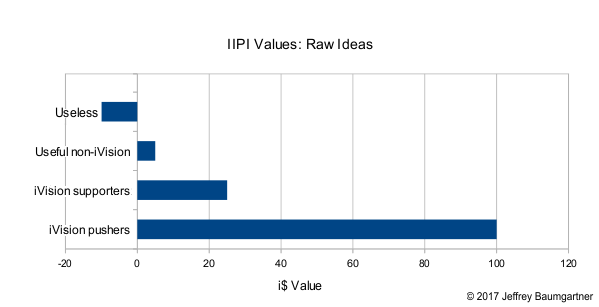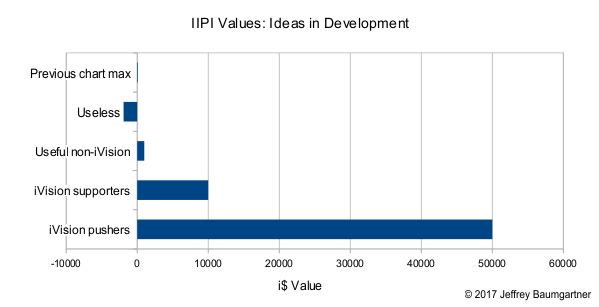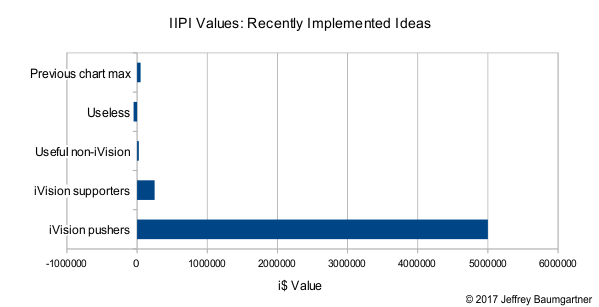The Innovation Initiative Performance Indicator (IIPI)
Introduction to Module 3
In this module we will look at the Innovation Initiative Performance Indicator, how it assigns value to ideas, how to use it and why it is more meaningful than other innovation measurement methods.
Pre-questions (questions to think about before moving forward):
- How do you measure the performance of your innovation initiative now?
- What are the strengths and weaknesses of your measurement system?
- Can you think of a better way to measure performance? Describe it.
Introducing the IIPI
One of the challenges facing innovation managers is measuring the performance of their initiative in a meaningful way. The metrics often used include numbers of ideas collected and participation levels. These may be nice numbers, but they are largely meaningless in terms of innovation results. It is rather like the marketing division measuring performance solely by the number of PowerPoint slides they make.
I decided to find a better way and I believe I have done so with the Innovation Initiative Performance Indicator (IIPI). The IIPI assigns a value "i$" to ideas according to idea type (as discussed in the previous module) and level of development.
The initial model was based on a simple thought experiment. I imagined I was at a café where people from competing companies hung out. I further imagined that someone from a competing company offered me an idea; nothing more, a simple, undeveloped idea. What would I be willing to pay for that idea? Not much. Raw ideas are undeveloped and unproven. Very likely, a raw idea is not as original as the owner believes it to be. Steve Jobs was not the only person on the planet to have the idea to replace a telephone keyboard with a touchscreen and fill it with apps. Indeed, IBM built and sold a smartphone some 15 years before the first iPhone was launched.
So, in this imaginary café, I reckoned I would be willing to shell out $100 − but certainly no more − for a raw, undeveloped and unproven iVision pusher idea. For a useful, non-iVision idea, I expect I would buy the owner a drink. So, let's put the value at $5. But, I absolutely do not want to hear a useless idea. It would spoil my drink and if someone threatened to bore me with a useless idea if I did not buy her a coffee, I would probably buy that coffee. So, useless ideas actually have a negative value: -$2.
The i$
Since this is a thought experiment, let's make them imaginary dollars or i$.
As an idea is developed, its i$ value increases. A prototype can demonstrate viability. Research can demonstrate commercial potential. A patent search can prove originality. And so on. Hence an idea in development has significantly more value than a raw idea. Likewise, a developed useless idea has negative value because that development is a waste of resources.
A recently implemented idea is presumably proven and so has more value still. Likewise, an implemented useless idea has greater negative value to reflect the waste of resources in its development and the likely cost of killing it. After implementation, ideas can largely be valued based on actual performance. Moreover, ideas in operation are usually far outside the realm of the innovation manager's responsibility. So, values of ideas after implementation are no longer relevant to the value of the innovation initiative.
Thus, the IIPI is applied to raw ideas, ideas in development and recently implemented ideas only. Let's look at the i$ values in IIPI
Raw Ideas
Raw ideas have the least value, because they are unproven. Here are their IIPI values:
| i$ Value | |
| iVision pushers | i$100 |
| iVision support | 25 |
| Useful non-iVision | 5 |
| Useless | -2 |
The chart below allows you to compare the values of the different idea types. As you can see, an iVision pusher idea is 20 times more valuable than a useful non-iVision idea, while an iVision supporter is worth five times as much as a non-iVision idea. Clearly, focusing innovative thinking on iVision related ideas produces much, much more value than collecting all kinds of ideas irrespective of their relevance to your iVision.

Ideas in Development
Ideas in development are ideas that are being developed for potential implementation. This may include building a prototype, developing a business case, market research and/or any other activities that take an idea from being a suggestion to being an implemented idea.
Ideas in development make a big value jump over raw ideas because, once an idea goes into development, it begins to become real. It is worthy of time and investment. It is tested, possibly modified and made viable. Once an idea goes into development, it is very likely to be implemented.
| i$ Value | |
| iVision pushers | i$50,000 |
| iVision support | 10,000 |
| Useful non-iVision | 1,000 |
| Useless | -2,000 |
| Previous chart maximum | 100 |

Note that iVison support and pusher ideas increase in value manifold over useful, non-iVision ideas during the development phase.
Recently Implemented Ideas
Once an idea has been developed and is actually implemented, its value takes another significant jump. Henceforth, it should be delivering value to the organisation.
| i$ Value | |
| iVision pushers | i$5,000,000 |
| iVision support | 250,000 |
| Useful non-iVision | 50,000 |
| Useless | -50,000 |
| Previous chart maximum | 50,000 |

Once again, we see that the value of ideas from the previous chart are insignificant in comparison to the value of implemented ideas. As an idea manager, it should be clear that the faster you can bring ideas to implementation, the greater their value. It also makes it clear why a database full of raw ideas is of little value and potentially of negative value if there are too many useless ideas.
Too many ideas penalty
In addition to the idea valuation above, there is a penalty for having too many raw, inactive ideas, by which we mean ideas that have been submitted to your initiative, perhaps via idea management software, perhaps submitted in some ideation activity. Your first 200 ideas are free of penalty. Thereafter, each 100 ideas incurs a cost of i$50. This is because a large number of inactive ideas has two costs to you:
- Administrative costs of dealing with a large number of ideas. You often need to sift through these ideas to identify ideas that have positive value. That wastes time.
- Too many inactive ideas demotivates your colleagues. If they know that many ideas submitted to your initiative remain unacted upon, they doubt their idea will be recognised or implemented. As a result colleagues submit fewer ideas and make less effort when they do.
How IIPI Helps Your Initiative
The IIPI does several things for you as an innovation manager. Firstly, it allows you to put a value to your innovation initiative at any given time. Over time, you can measure and report on the performance of your initiative in a way that is actually meaningful and representative of the value your initiative delivers to your organisation.
Secondly, IIPI helps you identify the most effective tools and activities for your initiative. Activities which collect lots of useful, non-iVision ideas and useless ideas bring little value to your organisation and, in a worst-case scenario, can actually bring negative value if it generates too many useless ideas. Unfortunately, many corporate idea generating tools focus on quantity of ideas over quality of ideas. These include brainstorming, suggestion schemes, idea management software and idea jams. Instead of tools like these, you want to use tools and organise activities that focus on quality of ideas over quantity (we'll look at some such activities and tools in module 5).
Thirdly, IIPI allows you to determine the value of products and services purchased to support innovation. A brainstorm consultant who leaves you with lots of low value ideas on Post-It notes is not really providing much value. A consultant who helps you build and develop iVision supporters and pushers, brings more value, while a consultant who helps you see ideas through to development and implementation brings the most value.
Exchange Rate
If you prefer to put IIPI i$ values into your own currency to make it more relevant, please do so. But use a consistent rate for all i$ conversions.
Worksheet Questions
Download the worksheet: | OpenOffice format | MS Word format |
- Calculate the value of your innovation initiative. You can approximate if you are managing a large initiative that processes a large number of ideas.
- What are you doing that brings little or negative value to your initiative?
- What brings the most value to your initiative?
- Where do you see opportunities to increase value?
